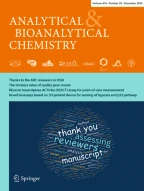Abstract
The presence of a wide variety of organic pollutants with different physicochemical characteristics has been investigated in wastewater samples from a municipal solid-waste-treatment plant in Castellón, Spain. An advanced analytical strategy was applied—combined used of two powerful and complementary techniques, GC and LC, both hyphenated with tandem mass spectrometry with triple-quadrupole analyzers. The GC–MS–MS method was based on sample extraction using C18 SPE cartridges and enabled the determination of approximately 60 compounds from different chemical families, for example PAHs, octyl/nonylphenols, PCBs, organochlorine compounds, insecticides, herbicides, and PBDEs. Most of the compounds selected are included as priority contaminants in the European Union (EU) Water Directive. The UHPLC–MS–MS method, which provided high chromatographic resolution and sensitivity and short analysis time, used sample extraction with Oasis HLB SPE cartridges and enabled the determination of 37 (more polar) pesticides. The methodology developed was applied to the analysis of 41 water samples (20 untreated raw leachates and 21 treated samples) collected between March 2007 and February 2009. Amounts of the contaminants investigated rarely exceeded 0.5 μg L−1 in the treated (reverse osmosis) water samples analyzed. As expected, in untreated leachates the number of compounds detected and the concentrations found were notably higher than in treated waters. The most commonly detected pollutants were herbicides (simazine, terbuthylazine, terbutryn, terbumeton, terbacil, and diuron), fungicides (thiabendazole and carbendazim), and 4-t-octylphenol. The results obtained proved that use of reverse osmosis for water treatment was efficient and notably reduced the amounts of organic contaminants found in raw leachate samples. In order to investigate the presence of other non-target contaminants, water samples were also analyzed by using GC–TOF MS and LC–QTOF MS. Several organic pollutants that did not form a part of the previous list of target contaminants were identified in the samples, because of the high sensitivity of TOF MS in full-spectrum acquisition mode and the valuable accurate-mass information provided by these instruments. The insecticide diazinon, the fungicide diphenylamide, the UV filter benzophenone, N-butylbenzenesulfonamide (N-BBSA), the insect repellent diethyltoluamide, caffeine, and the pharmaceuticals erythromycin, benzenesulfonanilide, ibuprofen, atenolol, and paracetamol were some of the compounds identified in the water samples analyzed.
Similar content being viewed by others
References
Pichon V (2000) J Chromatogr A 885:195–215
Oman C (2001) Environ Sci Technol 35:232–239
Schwarzbauer J, Heim S, Brinker S, Littke R (2002) Water Res 36:2275–2287
Council Directive 98/83/EC (3rd November 1998) Off J Eur Commun L330
Directive 2000/60/EC (23rd October 2000) Off J Eur Commun L327
Proposal of Directive COD/2006/0129 related to the Water policy: establishment of environmental quality standards EQS (amend. Directive 2000/60/EC) (17th July 2006) Brussels
Díaz Cruz MS, Barceló D (2008) Chemosphere 72:333–342
van Leeuwen SPJ, de Boer J (2008) J Chromatogr A 1186:161–182
Giger W (2009) Anal Bioanal Chem 393:37–44
Richardson SD (2009) Anal Chem 81:4645–4677
Santos FJ, Galceran MT (2002) Trends Anal Chem 21:672–685
Pitarch E, Medina C, Portolés T, López FJ, Hernández F (2007) Anal Chim Acta 583:246–258
Pitarch E, Marín JM, López FJ, Hogendoorn E, Hernández F (2007) Int J Environ Anal Chem 87:237–248
Hernández F, Marín JM, Pozo OJ, Sancho JV, López FJ, Morell I (2008) Int J Environ Anal Chem 88:409–424
Kuster M, López de Alda M, Barceló D (2009) J Chromatogr A 1216:520–529
Kasprzyk-Hordern B, Dinsdale RM, Guwy AJ (2008) Anal Bioanal Chem 391:1293
Gracia-Lor E, Sancho JV, Hernández F. J Chromatogr A (accepted, doi:10.1016/j.chroma.2009.11.090)
Batt AL, Kostich MS, Lazorchak JM (2008) Anal Chem 80:5021–5030
Bijlsma L, Sancho JV, Pitarch E, Ibánez M, Hernández F (2009) J Chromatogr A 1216:3078–3089
Wang J, Pang X, Ge F, Ma Z (2007) Toxicon 49:1120–1128
Gervais G, Brosillon S, Laplanche A, Helen C (2008) J Chromatogr A 1202:163–172
Marín JM, Gracia-Lor E, Sancho JV, López FJ, Hernández F (2009) J Chromatogr A 1216:1410–1420
Hernández F, Pozo OJ, Sancho JV, López FJ, Marín JM, Ibáñez M (2005) Trends Anal Chem 24:596–612
Sancho JV, Pozo OJ, Ibáñez M, Hernández F (2006) Anal Bioanal Chem 386:987–997
Hernández F, Portolés E, Pitarch E, López FJ (2007) Anal Chem 79:9494–9504
Portolés T, Pitarch E, López FJ, Sancho JV, Hernández F (2007) J Mass Spectrom 42:1175–1185
Ibáñez M, Sancho JV, McMillan D, Rao R, Hernández F (2008) Trends Anal Chem 27:481–489
Grange AH, Genicola FA, Sovocool GW (2002) Rapid Commun Mass Spectrom 16:2356–2369
Grange AH, Sovocool GW (2007) Environ Forensics 8:391–404
European Comission Decision 2002/657/EC (12th August 2002) Off J Eur Commun L221
Hernández F, Portolés T, Pitarch E, López FJ (2009) J Mass Spectrom 44:1–11
Acknowledgment
The authors acknowledge financial support from the Ministerio Español de Ciencia e Innovación (Project CTQ2009-12347), and also from Generalitat Valenciana as research group of excellence PROMETEO/2009/054. The authors are very grateful to the Serveis Centrals d’Instrumentació Científica (SCIC) of University Jaume I for the use of UHPLC–MS (TQD), GC–TOF MS (GCT), and UHPLC–QTOF MS (QTOF Premier). This work has been developed under financial support of RECIPLASA as a part of the project “Investigación de contaminantes orgánicos en las aguas de lixiviado de residuos urbanos de la planta de compostaje de Onda”.
Author information
Authors and Affiliations
Corresponding author
Electronic supplementary material
Below is the link to the electronic supplementary material.
ESM 1
(PDF 458 kb)
Rights and permissions
About this article
Cite this article
Pitarch, E., Portolés, T., Marín, J.M. et al. Analytical strategy based on the use of liquid chromatography and gas chromatography with triple-quadrupole and time-of-flight MS analyzers for investigating organic contaminants in wastewater. Anal Bioanal Chem 397, 2763–2776 (2010). https://doi.org/10.1007/s00216-010-3692-x
Received:
Revised:
Accepted:
Published:
Issue Date:
DOI: https://doi.org/10.1007/s00216-010-3692-x
